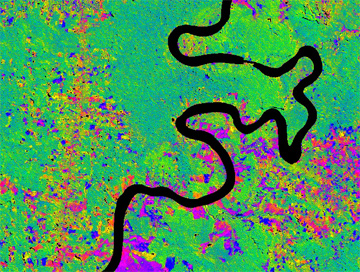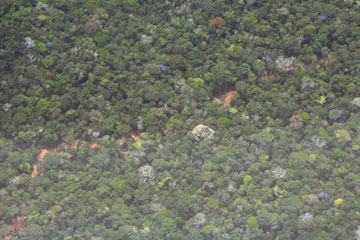Experts: parks effectively protect rainforest in Peru
Experts: parks effectively protect rainforest in Peru
mongabay.com
August 9, 2007
High-resolution satellite monitoring of the Amazon rainforest in Peru shows that land-use and conservation policies have had a measurable impact on deforestation rates. The research is published in the August 9, 2007, on-line edition of Science Express.
Analyzing seven years of high-resolution satellite data covering 79 percent of the Peruvian Amazon, scientists at the Carnegie Institution’s Department of Global Ecology found that only 1 to 2 percent of forest disturbance occurs in protected areas, which are 18 times more effective at reducing deforestation than unprotected areas.
“We found that only 1 to 2 % of this disturbance in Peru happened in natural protected areas,” noted lead author Paulo Oliveira. “However, there was substantial forest disturbance adjacent to areas set aside for legal logging operations. This leakage of human activity outside of logging concessions is a concern.”
Peru has some 255,000 square miles (661,000 square kilometers) of tropical forests—an area second only to Brazil and larger in extent that the entire country of France. With deforestation rates historically under 1 percent, forest loss in the South American country has been comparably low relative to neighboring countries, especially Ecuador. By 2005 the Peruvian government had put roughly 40,000 square miles of forest into long-term commercial timber production, while setting aside large areas as parks and indigenous reserves.

These Carnegie Landsat Analysis System images show two regions of the Peruvian rain forest (green). Blue and red indicate areas of deforestation. (Image courtesy the Asner Lab, Department of Global Ecology, Carnegie Institution.) |
To assess the effectiveness of these measures as well as gauge the impact of other pressures on forests in Peru, Carnegie Institution scientists employed the Carnegie Landsat Analysis System (CLAS), a “satellite-based forest-damage detection system” which can penetrate the rainforest canopy to reveal the impact of logging activities.
“Our approach has improved over the past eight years, but relies on a core set of methods that have consistently worked,” Asner said. “We spent years developing them in Brazil, then went to Peru and completed this study in only a year. We are now operating over Borneo. Our approach is proving a good way to monitor rain forest disturbance and deforestation anywhere in the world.”
The researchers found that, between 1999 and 2005, forest disturbance and deforestation rates averaged only 244 square miles and 249 square miles per year respectively, or less than 0.2 percent per year, one of the lowest rates among tropical countries. About 86 percent of the damaged Peruvian areas were in two regions—in the Madre de Dios, in southeastern Peru, and in the central eastern part of the country near Pucallpa. 75 percent of the damage (66 percent of disturbances and 83 percent of deforestation) was found within 12.5 miles (20 km) of the roads.

Hidden threat? Logging road under the forest canopy in Peru. Photo by Rhett A. Butler. |
“Overall, only 2% of the forest disturbances and 1% the deforestation detected in the entire study area occurred within the boundaries of natural protected areas. Furthermore, territories occupied by indigenous communities contained 11% and 9% of the total forest disturbance and deforestation,
respectively,” write the authors. “These results clearly show that these two forms of land-use allocation can provide effective protection against forest damage.”
“The establishment of protected natural areas, the titling of native territories, and the sanctioning of selective logging activities, have combined with the Peruvian Amazon’s traditional conservation allies—its remoteness and a complex hydrological network—to ensure a moderate level of success in the conservation of its forest ecosystems. Economic development of the forest sector, which employed 279,000 people nationally in 2001 (24), is essential for the well-being of human populations, but poorly monitored logging concessions, along with the challenges of uncontrolled road access, may hinder efforts to maintain ecological function and diversity in Peruvian rainforests in the future,” the authors continue.
“Increased satellite monitoring of logging and other forest disturbances will thus be essential to conservation, management and resource policy development efforts in Peru and other rainforest nations,” they conclude.
CITATION: P.J.C. Oliveira, G.P. Asner, D.E. Knapp, A. Almeyda, R. F. Raybin, A. Almeyda, R. Galván-Gildemeister, R.C. Smith, and S. Keene. (2007). Land-Use Allocation Protects the Peruvian Amazon. 9 AUGUST 2007 Science Express.
Related articles
Selective logging leads to clear-cutting in the Amazon rainforest. A new study links selective logging to clear-cutting in the Amazon rainforest. The research is significant because it identifies “an important indicator of rain forest vulnerability to clear-cutting in Brazil.”
Better forest policies would reduce illegal logging in the Amazon Brazil could improve sustainable forest management, reduce illegal logging, and perhaps cuts deforestation by introducing coherent policies for timber operations in the Amazon rainforest argues a new paper published in Frontiers in Ecology. However, successful implementation of sustainable timber production will require overcoming significant biological and political hurdles, suggest the authors.
Logging impact worse than thought in the Amazon. Research released earlier this month in Science found that Brazil’s Amazon rain forest is being degraded twice as fast as deforestation figures suggest. Selective logging, where only one or two valuable tree species are harvested from an area, is driving the forest degradation. The findings have important implications for “sustainable harvesting” schemes that have been promoted as ecologically-sound alternatives to traditional harvesting techniques.
This article uses quotes and information from a Carnegie Institution news release and the Science Express article.














